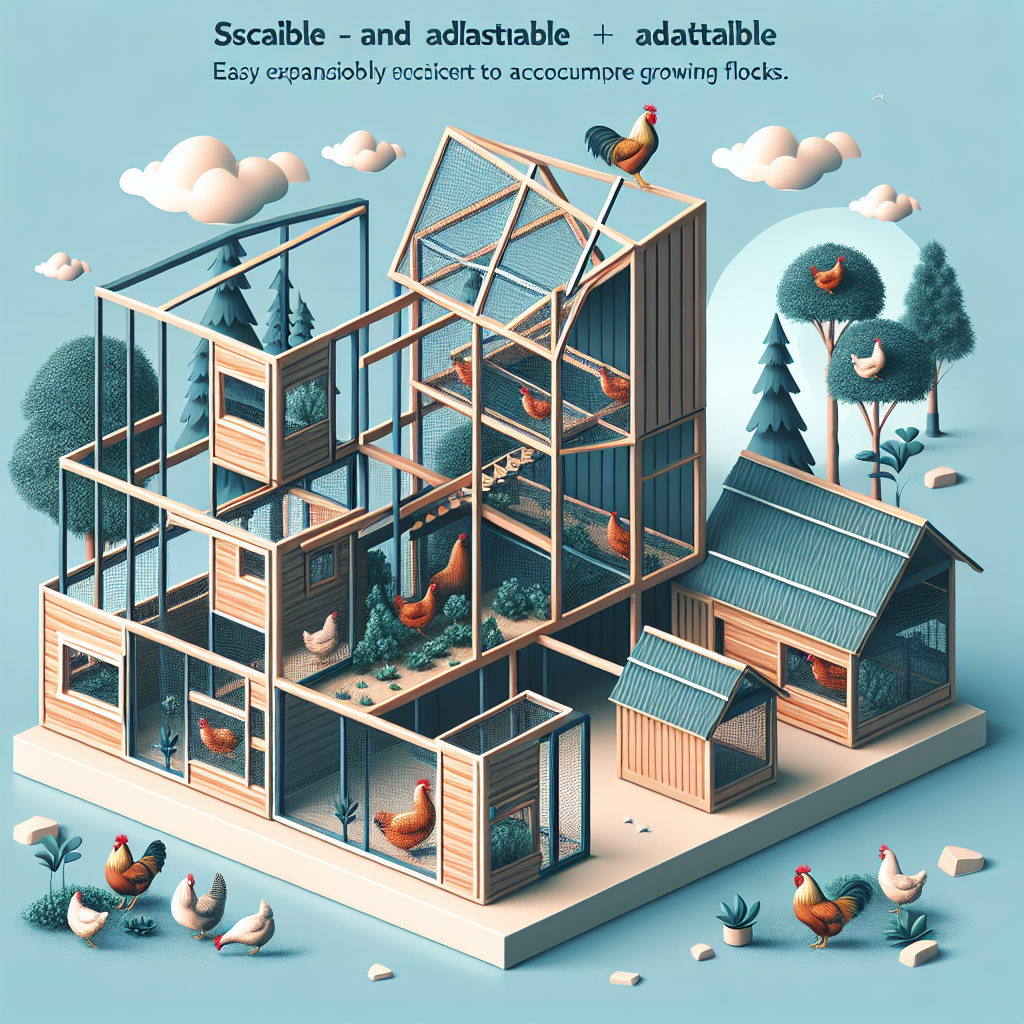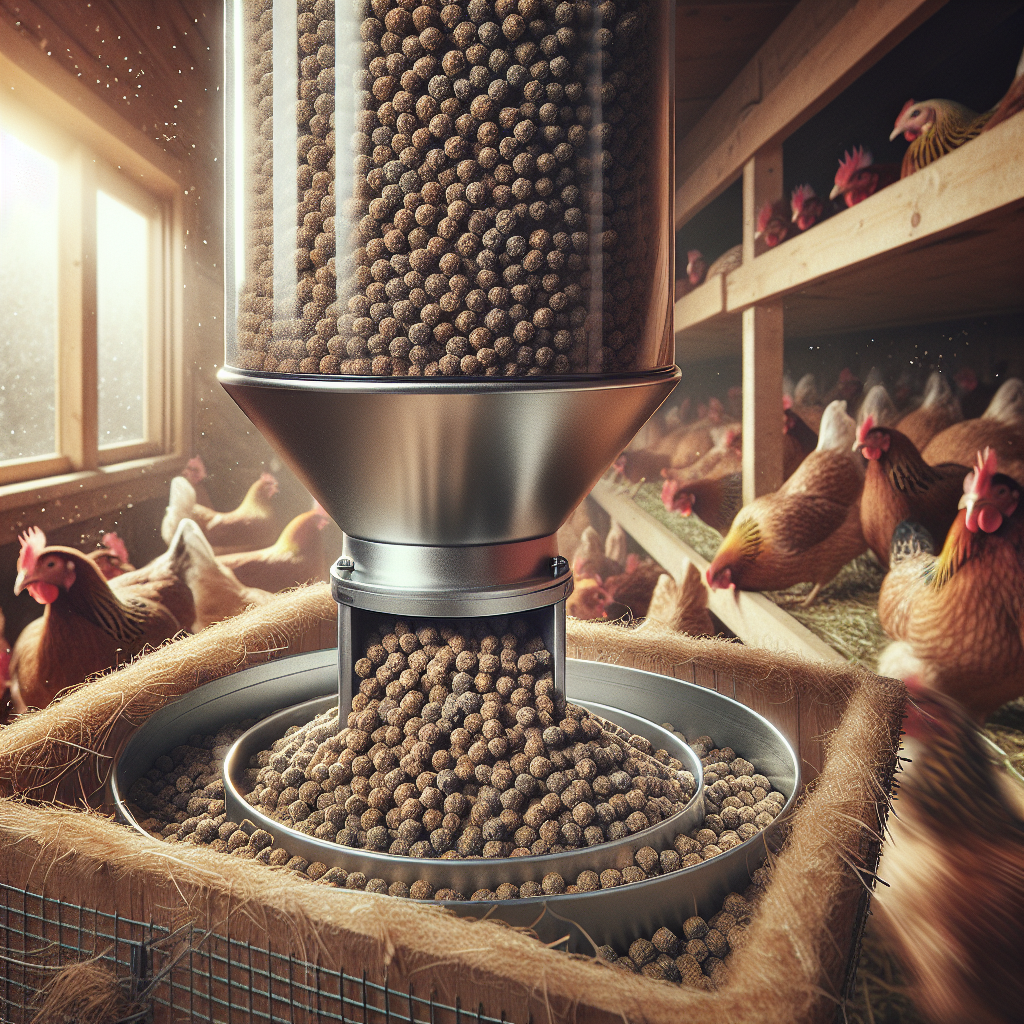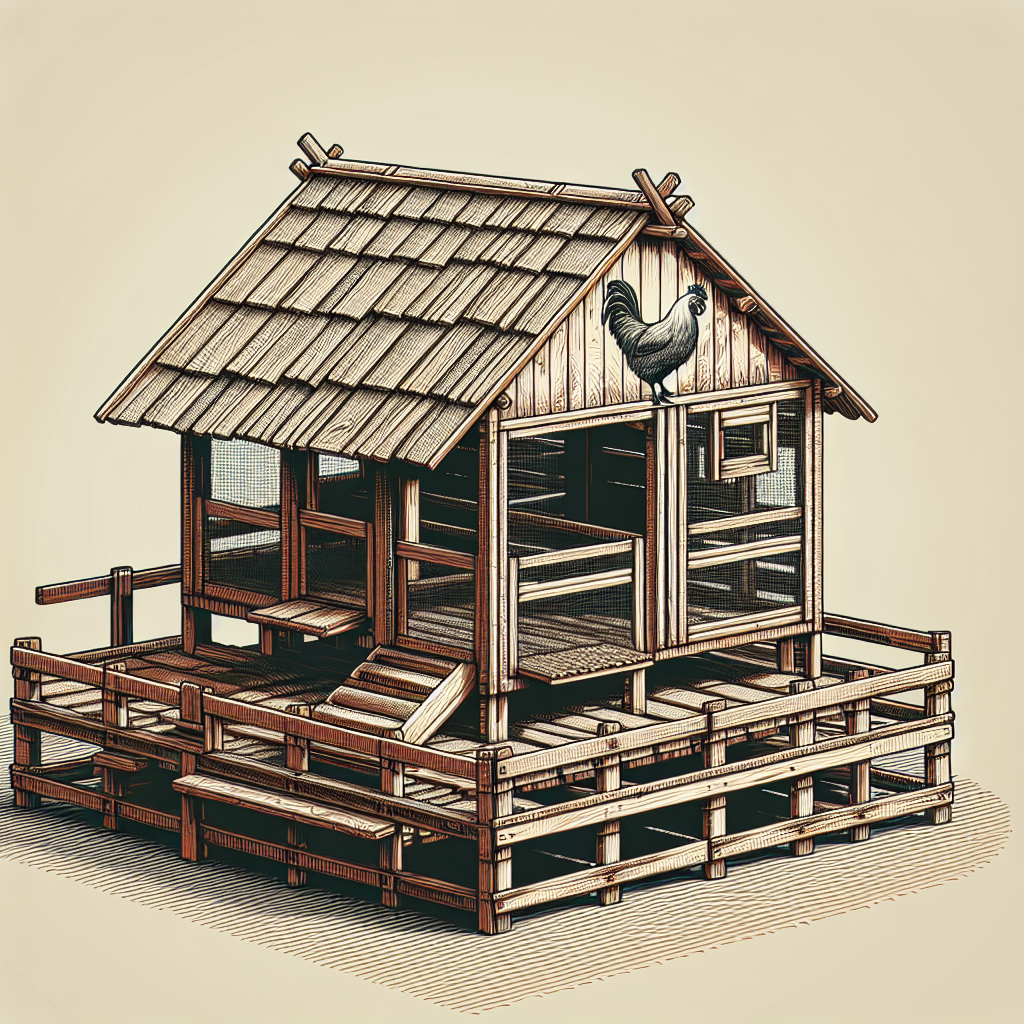You’ve decided to build your own chicken coop, but you want to make sure it can accommodate a growing flock in the future. As you work on your chicken coop design, you’re determined to find ways to make it expandable without sacrificing its functionality or aesthetics. After all, owning chickens can be a rewarding and sustainable hobby, and you want to set yourself up for success from the start. In this article, we will explore various strategies and tips to help you create a chicken coop design that can easily adapt to your flock’s growth over time, ensuring that your feathered friends have a comfortable and spacious home.
Designing a Flexible Layout
Allowing for Modular Expansions
When designing a chicken coop for future growth, it is essential to create a flexible layout that allows for modular expansions. By incorporating modular components, such as removable walls or dividers, you can easily adjust the coop’s size and configuration as your flock grows. This flexibility ensures that you can accommodate a larger number of chickens without having to completely rebuild or redesign the coop.
Choosing a Scalable Foundation
Another critical aspect of designing an expandable chicken coop is selecting a scalable foundation. Opting for a foundation that can easily be extended or modified will simplify future expansions. For example, instead of using a fixed concrete base, consider using pavers or gravel that can be easily adjusted to accommodate a larger coop or run area.
Creating Adjustable Roosting Areas
Roosting areas are an essential component of any chicken coop, and designing them to be adjustable can greatly enhance flexibility. By incorporating adjustable roosting bars or perches, you can easily reconfigure the coop to accommodate different flock sizes or breeds. This allows you to provide adequate space and comfort for your chickens as they grow.
Incorporating Removable Dividers
To further enhance the flexibility of your chicken coop design, consider incorporating removable dividers. These dividers can be used to create separate areas within the coop, making it easier to introduce new birds or isolate sick or injured chickens. By utilizing removable dividers, you can adapt your coop to meet the specific needs of your flock, both now and in the future.
Planning for Adequate Space
Determining the Optimal Coop Size
When designing a chicken coop for future growth, it is crucial to determine the optimal coop size for your current and anticipated flock. Consider factors such as the number of chickens, their breed, and their behavior patterns to ensure that there is enough space for them to move comfortably. It is recommended to allow at least 4 square feet of space per chicken in the coop.
Allocating Room for Future Additions
To accommodate future additions to your flock, allocate extra space within your initial coop design. This will save you from the hassle of expanding or rebuilding the coop entirely when you decide to raise more chickens. By planning ahead and providing additional square footage, you can easily integrate new birds into your existing coop without overcrowding.
Considering Vertical Expansion
In addition to planning for horizontal expansion, it is also important to consider vertical expansion when designing your chicken coop. By utilizing the vertical space effectively, you can maximize the available floor area while providing ample room for your chickens. Consider incorporating features such as stacking nesting boxes or multi-level perches to make the most of the coop’s vertical space.
Future-Proofing the Structural Framework
Using Sturdy and Durable Materials
To ensure the longevity and future expandability of your chicken coop, it is essential to use high-quality, sturdy, and durable materials. Opt for materials such as pressure-treated lumber or metal framing to provide a solid foundation for your coop’s structure. Using materials that can withstand the test of time and various weather conditions will minimize the need for frequent repairs or replacements as your flock grows.
Building a Solid Foundation
A strong and stable foundation is crucial for an expandable chicken coop. Ensure that your coop is built on level ground and use appropriate techniques to secure the foundation. Consider using concrete footings or treated wood posts to provide a solid base that can support future expansions or additional structures, such as an attached run.
Adopting a Secure Roof Design
When designing your chicken coop, it is vital to adopt a secure roof design that can withstand heavy loads and protect your flock from the elements. A strong and durable roof will ensure the safety and comfort of your chickens, especially as the coop expands. Invest in quality roofing materials that are suitable for your climate and can withstand wind, rain, and snow.
Enhancing Structural Integrity with Bracing
To future-proof the structural framework of your chicken coop, incorporate bracing techniques that enhance its stability and durability. Adding diagonal bracing or additional support beams will strengthen the coop’s overall structure, allowing it to withstand the test of time and any potential expansions. By reinforcing the framework, you can ensure the safety and longevity of your coop.
Ensuring Proper Ventilation and Lighting
Installing Adjustable Ventilation Systems
Proper ventilation is crucial for the health and well-being of your chickens. When designing an expandable chicken coop, it is important to install adjustable ventilation systems that can accommodate a growing flock. Consider incorporating adjustable vents or windows that can be opened or closed as needed to provide adequate airflow and prevent the buildup of ammonia and moisture.
Incorporating Windows for Natural Light
Natural light is essential for the overall health and productivity of chickens. When designing your coop, incorporate windows that allow ample natural light to enter. Not only does natural light provide a more comfortable environment for your flock, but it also reduces the need for artificial lighting during the day. By strategically placing windows, you can ensure that your coop receives optimal sunlight throughout the day.
Integrating Artificial Lighting for Flexibility
In addition to natural light, it is important to consider artificial lighting options when designing your chicken coop. Artificial lighting can be used to extend the daylight hours during the winter months, promoting egg production and maintaining a consistent laying schedule. By incorporating adjustable lighting fixtures, you can easily adapt the lighting conditions in your coop as your flock grows or as seasonal changes occur.
Implementing Easily Expandable Feeding and Watering Systems
Choosing Versatile Feeders
When designing a chicken coop for future growth, it is crucial to choose versatile feeders that can easily be expanded or adjusted. Consider using hanging feeders or trough-style feeders that can accommodate a larger number of chickens. Additionally, opt for feeders that allow for easy cleaning and refilling to minimize maintenance efforts as your flock expands.
Opting for Expandable Watering Solutions
Similar to feeders, it is important to choose expandable watering solutions for your chicken coop. Consider using nipple waterers or automatic watering systems that can be easily connected to a larger water source. These systems allow for easy expansion as your flock grows, ensuring that your chickens always have access to clean and fresh water.
Creating Space for Additional Feeders and Waterers
When planning the layout of your chicken coop, allocate sufficient space for additional feeders and waterers in the future. Designating specific areas within the coop for these accessories will allow for easy installation and expansion without disrupting the overall functionality of the coop. By planning ahead, you can seamlessly integrate additional feeding and watering systems as your flock expands.
Providing Adequate Nesting Boxes
Calculating the Nesting Area Requirements
To meet the future nesting needs of your flock, it is important to calculate the adequate nesting area requirements for your chickens. Generally, one nesting box is recommended for every 3-4 hens. However, keep in mind that this calculation may change as your flock grows. By accurately determining the current and future nesting requirements, you can design a coop that will accommodate your expanding flock.
Incorporating Modular Nesting Boxes
One way to ensure that your chicken coop remains expandable for future growth is to incorporate modular nesting boxes. These nesting boxes can be easily added or removed as needed, providing flexibility and adaptability as your flock increases in size. By opting for modular designs, you can efficiently utilize the available space and adjust the number of nesting boxes to meet the demands of your chickens.
Leaving Room for Additional Nesting Boxes
When designing your chicken coop, it is important to leave room for additional nesting boxes in the future. By allocating extra space for nesting boxes, you can easily expand the coop’s capacity without compromising the comfort and privacy of your chickens. Consider leaving an empty wall or designated area where nesting boxes can be added as your flock grows.
Utilizing Adjustable Fencing
Opting for Removable or Extendable Fencing Structures
To ensure that your chicken coop is expandable for future growth, it is advisable to opt for removable or extendable fencing structures. By choosing fencing options that can be easily relocated or extended, you can easily modify the coop’s run area as your flock grows. This flexibility enables you to periodically change the configuration of the run without much effort or additional expenses.
Designing Gates with Future Expansion in Mind
When designing the entrances and gates for your chicken coop, it is important to consider future expansion. Incorporate wide gates that can accommodate larger numbers of chickens or equipment, such as wheelbarrows or feed carts, that may be necessary as your flock grows. By considering the potential future needs, you can save yourself the trouble of having to modify or replace gates later on.
Considering Additional Outdoor Enclosures
In addition to the main chicken coop, it is often beneficial to consider additional outdoor enclosures for your flock’s expansion. Areas such as chicken runs or fenced-in pastures provide more space for your chickens to forage and exercise. Designing these additional enclosures with expandability in mind, such as using flexible fencing options, allows you to easily increase the available outdoor space as your flock grows.
Implementing Easy Access and Maintenance Features
Installing Removable Flooring for Cleaning
To ensure easy access and maintenance of your chicken coop, consider installing removable flooring. Removable flooring, such as linoleum or removable trays, allows for easy cleaning and prevents the buildup of waste and potential health hazards for your flock. By implementing this feature, you can maintain a clean and hygienic environment for your chickens without the hassle of disassembling or reconfiguring the entire coop.
Creating Accessible Doors and Windows
When designing the doors and windows of your chicken coop, prioritize accessibility for both humans and chickens. Ensure that doors are wide enough for easy entry and exit, allowing you to retrieve eggs or perform routine maintenance tasks without difficulty. Similarly, incorporate windows that can be easily opened and closed to provide adequate ventilation without compromising security.
Incorporating Modular Roofs for Repairs
Roof maintenance is an inevitable part of owning a chicken coop, and designing the roof with future repairs in mind is essential. Incorporate modular roof sections that can be easily removed or replaced in the event of damage or leaks. This feature will save you time and effort when it comes to roof repairs, ensuring that your coop remains functional and secure for your expanding flock.
Considering Future Environmental Factors
Planning for Insulation and Energy Efficiency
When designing your chicken coop, it is important to plan for insulation and energy efficiency to accommodate future environmental factors. Consider insulating the walls and roof of your coop to regulate temperature and prevent extreme heat or cold. Additionally, choose energy-efficient materials such as double-pane windows or solar-powered ventilation fans to minimize energy consumption and reduce environmental impact.
Allowing for Climate Control Systems
For regions with extreme climates, it may be necessary to incorporate climate control systems into your chicken coop design. Planning ahead and allocating space for heating or cooling systems will ensure the comfort and well-being of your flock year-round. By considering these future environmental factors, you can create an expandable coop that can adapt to changing weather conditions.
Accommodating Alterations for Changing Temperatures
In addition to insulation and climate control systems, it is important to accommodate alterations for changing temperatures within your chicken coop design. This can include features such as adjustable windows or removable panels that allow for increased ventilation during hot summers or increased insulation during cold winters. By providing the flexibility to adapt to changing temperatures, you can ensure the health and comfort of your flock as they grow.
Thinking About Future Livestock Expansion
Designing Removable or Expandable Runs
In addition to chickens, you may also have plans to expand your livestock in the future. When designing your chicken coop, consider incorporating removable or expandable runs that can accommodate other animals, such as ducks or turkeys. By designing these runs to be easily adjustable, you can add or remove sections as needed to introduce new livestock into your farm.
Adding Extra Coop Space for More Chickens
If you anticipate expanding your chicken flock significantly, it is important to design your coop with additional space in mind. Adding extra coop space from the start ensures that you won’t face overcrowding issues as your flock grows. Consider leaving empty areas that can be easily partitioned or used for future expansions, providing your chickens with ample space to thrive.
Incorporating Space for Other Poultry or Livestock
When designing your chicken coop, think beyond chickens and consider other poultry or livestock that you may want to raise in the future. Whether it’s ducks, geese, rabbits, or goats, incorporating space for additional animals in your coop design will save you the trouble of building separate structures later on. By planning for future expansion of various livestock, you can create a cohesive and adaptable farming environment.
In conclusion, designing an expandable chicken coop requires careful planning and consideration of various factors. By allowing for modular expansions, allocating adequate space, future-proofing the structural framework, ensuring proper ventilation and lighting, implementing easily expandable feeding and watering systems, providing adequate nesting boxes, utilizing adjustable fencing, implementing easy access and maintenance features, considering future environmental factors, and thinking about future livestock expansion, you can create a chicken coop that grows with your flock and meets their evolving needs. By approaching the design process with foresight and flexibility, you can ensure a comfortable and sustainable environment for your chickens while minimizing the need for costly and time-consuming modifications in the future.




